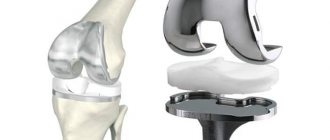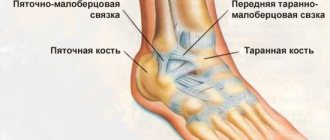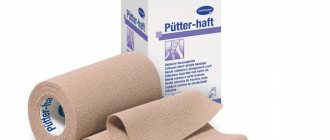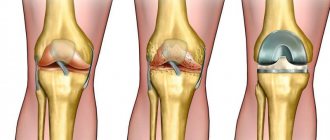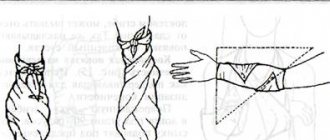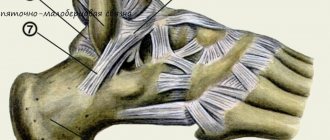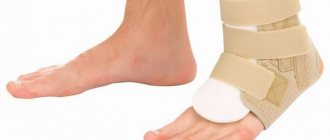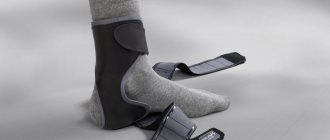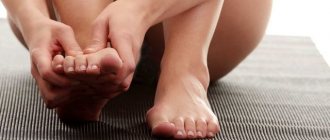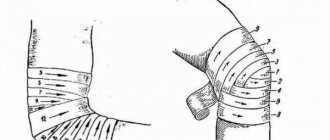An ankle orthosis is used to treat and prevent injuries to the ankle joint. In some cases, an ankle brace may be used instead of an ankle cast to provide a secure fit and prevent muscle atrophy. Orthopedic ankle orthoses help normalize foot position and gait. There are many types of orthoses and options for their use (for example, an ankle orthosis is often used after an ankle fracture). To obtain truly effective ankle treatment, the orthosis must be selected correctly, based on the type of disease and the size of the leg.
Traumatologists and orthopedists at the Yusupov Hospital will help you choose an ankle orthosis. Doctors have extensive experience in treating various pathologies of the ankle joint and create a treatment plan that will be most effective for a given patient.
When is an ankle orthosis needed?
Orthoses are used for the treatment and prevention of diseases of the musculoskeletal system. A specialized orthosis has been developed for each joint, which differs in its composition and functions. There are a huge number of types of ankle orthoses:
- dynamic orthosis for enhanced stabilization of the ankle joint;
- unloading ankle orthosis;
- ankle-foot orthosis, immobilizing, articulated, adjustable, etc.
The main functions of an ankle orthosis include:
- joint fixation;
- reducing the load on the joint;
- restriction of movements.
An ankle orthosis allows you to reduce pain and fix the joint in an anatomically correct position to prevent the development of a pathological process and restore damaged tissues. An ankle orthosis may also be used for an ankle fracture. It perfectly replaces a plaster cast and is much more convenient to use.
An ankle brace is recommended for use by athletes and people with habitual joint dislocation. During excessive physical activity (sports, heavy lifting, long walking), the orthosis protects the joint from excess stress, which prevents damage.
An ankle orthosis is prescribed by a doctor. It should not be used without specialist advice. At the Yusupov Hospital, you can get advice from a qualified traumatologist or orthopedist about the need to use an orthosis. The doctor will assess the condition of the ankle and make recommendations for the most effective and safe restoration of lost functions.
Ankle orthosis: types, degrees of fixation, how to choose
An ankle orthosis is a simple and effective means of immobilization, which is used for instability, injuries, inflammatory processes in the ankle, as well as during sports. The purpose of the bandage is to fix the joint to one degree or another, reducing the load. Depending on the rigidity, the orthosis can be considered as a replacement for an elastic bandage or plaster cast; with light and medium degrees of fixation, the use does not require wearing special shoes.
Types of ankle orthoses by functionality
- unloading - to reduce the impact on the joint without limiting mobility;
- corrective - to gradually eliminate or prevent the development of joint and distal deformities;
- fixing - for immobilization of the joint after injury or during exacerbation of the inflammatory process;
- dynamic - to restore joint mobility in an unstable state of the muscular system, for example, after a stroke.
Manufacturers of ankle orthoses presented in our GLAWORTH store always indicate the functionality of the products and their intended use. However, the final decision must be made by a specialist. Catalog of ankle-foot orthoses at this link.
Degrees of fixation of ankle orthoses
Lightweight - achieved by using elastic bandages without stiffeners or inserts. Products in this category are used for bruises, sprains, dislocations, and they are also used in sports to reduce the load on the joint. The group of light fixation also includes the so-called medicinal bandages, the elastic fabric of which is impregnated with medications to speed up the recovery of the joint or disinfect the wound. The elastic bandage is invisible under clothing, does not require changing shoes and can be worn around the clock, including by children.
Medium/moderate - ensured by adding stiffeners (metal, plastic) to the elastic material. Orthoses of this degree of rigidity are indispensable for people with chronic ankle instability; in addition, they are used for injuries of moderate severity and during the rehabilitation period after operations. A distinctive feature is the combination of massage and compression (warming) effects, which contribute to the restoration of the joint.
Strong/semi-rigid - used as an alternative to a plaster cast for injuries with ligament damage, severe ankle instability, flaccid foot paralysis and other pathologies. The product is a durable elastic woven boot with stiffening ribs and additional fixing inserts. The design includes lacing or Velcro fasteners to select optimal fixation parameters and change them as necessary.
Full/rigid - for complete immobilization of the foot in case of ankle fractures. The product includes a frame made of medical plastic and rigid inserts that ensure reliable fixation of the joint. Since this product is worn around the clock, manufacturers pay special attention to the quality of materials in contact with the skin - the appearance of pathogenic flora is excluded, and the foot is provided with maximum comfort due to moisture removal and ventilation.
When an orthosis is a replacement for plaster
Depending on the extent of the ankle injury, your doctor may recommend a semi-rigid or rigid ankle brace. In the first case, the product will be elastic, in the second - made of medical plastic with complete fixation of the joint for proper fusion of bones. Since the orthosis, unlike a plaster cast, is removable, wearing it does not interfere with regular examination by a specialist. As you recover, the plastic structure can be easily replaced with an elastic product of semi-rigid fixation with a precise fit to the leg. Excellent breathability and the absence of allergenic materials and components allow you to maintain the injured limb in comfort. Light massage and warming effects accelerate recovery. For closed ankle fractures, there are no contraindications to replacing the plaster cast with an express orthosis of the appropriate degree of fixation.
How to choose an orthosis
An ankle orthosis of any degree of fixation is an orthopedic product, so its use requires specialist advice. If you have received them, then you just have to choose a model. The assortment of the GLAVORT online store includes only bandages and orthoses from brands with a high reputation in the Russian and global markets and positive reviews from orthopedists. Please note: all medical products are certified and contain clear manufacturer recommendations for sizing. Size tables are given in product descriptions. If you find it difficult to choose, then use the help of GLAVORT specialists - they have special knowledge sufficient to select orthopedic products according to your requirements and doctors’ recommendations.
Soft ankle-foot orthosis
The soft ankle cut is a product made of elastic fabric, which in action resembles an elastic bandage. The soft orthosis is easy to use, and unlike a bandage, it is easy to put on and take off without fear of squeezing blood vessels. A soft orthosis is prescribed for minor bruises, dislocations, at the initial stage of an inflammatory or destructive-degenerative process, and at the last stages of rehabilitation after injury or surgery. The price for a soft ankle orthosis is from 1100 rubles.
For chronic joint instability, a soft ankle orthosis with silicone inserts is quite effective. The price of the product will be slightly higher than a regular soft orthosis and starts from 3,000 rubles. A soft ankle-foot orthosis with silicone inserts is also used for mild injuries and illnesses, and to prevent the development and progression of pathologies. An ankle orthosis with silicone inserts provides additional local compression and has a massage effect.
Ankle orthosis, semi-rigid, medium fixation
A semi-rigid ankle orthosis is prescribed for the treatment and prevention of ankle pathologies. An ankle orthosis with a medium degree of fixation has fixing elements and stiffening ribs that ensure reliable fastening of the ankle in the required position. The damaged areas of the ankle are relieved of excess stress and the healing process begins. The elastic fabric of the orthosis provides additional compression and ensures normalization of blood circulation in the affected area.
This type of orthoses is widely represented on the orthopedic products market. It can be found in such widespread distribution networks as Ladomed (semi-rigid ankle orthosis with medium fixation) or Orteka (semi-rigid ankle orthosis). The price of an orthosis for an ankle joint of medium rigidity varies from 2000 rubles. Doctors at the Yusupov Hospital will help you decide on the choice of orthosis and recommend the most optimal one.
Ankle foot orthosis, semi-rigid, strong fixation
A strong ankle orthosis is necessary to reliably limit ankle movement. An ankle orthosis with strong fixation ribs is used for:
- ankle fractures;
- ligament ruptures;
- severe bruise of the ankle joint;
- joint diseases (arthritis, arthrosis, etc.);
- after prosthetics;
- after operation.
In the Ladomed network, ankle foot orthoses with a strong degree of fixation are presented by many different manufacturers: Otto Bock ankle orthoses, Push ankle orthoses, Orlette ankle orthosis and others.
Indications for the use of such a bandage
The main indications for the use of ankle orthoses are the following situations:
- The presence of inflammatory processes and injuries that affect the ankle joint - arthritis, arthrosis and others.
- Fractures and chips in the ankle area.
- Damage to foot ligaments.
- Dislocation, subluxation and other conditions in which instability of the joint position is observed.
- Relief of pain and discomfort due to pathologies and abnormalities of the foot.
- For the prevention of injuries and problems in professional athletes or people suffering from excess weight.
- Only a doctor can determine the need to use an ankle orthosis.
Ankle orthosis with lacing and stabilizing insert
A type of semi-rigid orthopedic product is a lace-up ankle orthosis. The orthosis is equipped with special lacing, which ensures anatomically correct fixation of the leg. A semi-rigid ankle orthosis with lace allows you to hold the leg in a position in which the injured area will be effectively restored. The lace-up ankle brace also has special inserts that mold to the shape of your foot for safe movement. This type of orthosis is used in the following cases:
- ankle injury;
- foot paresis;
- joint diseases;
- pain syndrome;
- post-traumatic syndrome;
- excessive physical activity.
Key functions of orthoses
Different orthoses are designed to perform different tasks and functions:
- relieve stress from the back (spine) and joints;
- fix the body (its specific area) in the desired position;
- restore the functionality of a limb after surgery or injury;
- correct congenital and acquired deformities - such as kyphosis, scoliosis, etc.;
- relieve acute pain caused by arthrosis, arthritis, osteochondrosis or other chronic disease;
- act as a preventive measure - minimize the risk of injury to joints and back during training, long-term driving, and other physical activity.
When choosing a suitable medical device, it is necessary to take into account its intended purpose.
Rigid ankle orthosis
A rigid ankle orthosis is designed to immobilize the leg after serious injury, fractures, or operations. A rigid orthosis is effective for restoring a joint as a result of the progression of degenerative processes in the tissues of the joint. It has a durable design that immobilizes the joint at the required level. Depending on the pathology, a rigid orthosis can be used to completely immobilize the leg until tissue integrity is restored. Over time, the clamps are loosened to normalize ankle mobility. Rigid fixation is provided by belts, Velcro (or lacing), special inserts and stiffening ribs. This type of product is produced by popular companies Otto Bock (ankle orthoses with rigid fixation), Orlette, etc.
A type of orthopedic product is a rigid derotational ankle orthosis. This is a specialized orthosis that is used in the following situations:
- DPC;
- after a stroke;
- after spinal cord injuries;
- after orthopedic surgery;
- at risk of developing foot deformity.
Some pharmacy chains and health care stores offer rigid derotational ankle orthoses for sale: Samson Pharma, Ladomed, Orteka, etc. The price for a rigid derotational ankle orthosis ranges from 4,000 rubles. When using this type of orthosis, you should strictly follow the recommendations of your doctor. At the Yusupov Hospital in the rehabilitation center, patients can receive advice on methods of recovery from diseases of the nervous system and brain, as well as undergo a course of treatment.
Choosing the right ankle orthosis size
We remind you that the orthosis must be prescribed by a doctor, based on the diagnosis and individual characteristics of the patient (age, weight, etc.). In addition to the recommendations of the attending physician, it is necessary to take into account such factors as:
- foot size;
- width of the ankle, ankle, lower leg, ankle.
The size of the ankle joint orthosis will depend on them. And remember: the more optimal the size of the orthosis is selected, the better. A product of the wrong size will not have the desired effect, but may well aggravate the problem.
You can get practical advice on how to determine the size of an ankle orthosis in our salon, where highly qualified specialists work.
Example of sizing for
Adjustable ankle brace
An ankle orthosis with degree setting and a motion controller is classified as semi-rigid and rigid products. It unloads and stabilizes the joint. The point of changing the angle set on the ankle orthosis is that this ensures a gradual restoration of the extensor ability of the joint. The angle of the foot to the leg can be changed in 10-degree increments, while the lateral areas of the ankle remain stabilized. This orthosis is highly effective for injuries of the Achilles tendon, providing immobilization of the joint during plantar flexion. Soft inserts in the heel serve as shock absorbers and help reduce the load on the joint when walking.
Ortek adjustable ankle orthoses are quite popular. How to adjust the ankle orthosis is indicated by the attending physician, depending on the nature of the damage.
What materials are used to make ankle braces?
Different materials are used to make these orthopedic models. They are selected depending on the functions that the latch must perform.
This can be neoprene, which retains heat and eliminates swelling and pain. For people prone to allergies, it is better to opt for products that contain a high percentage of cotton.
Some elastic models use silicone inserts. They guarantee more reliable compression and fixation. Such models are especially good for high loads on the leg (for example, in sports or during heavy physical work).
For models recommended for fractures or severe sprains and ligament tears, rigid inserts made of plastic or metal are used. Only if these clamps are used will the leg be reliably immobilized and the injury will not get worse when moving.
Ankle orthosis for drop foot
To treat flaccid paralysis or floppy foot syndrome, which occurs as a result of pathologies in the central nervous system, special orthoses are used. They consist of two parts connected by an elastic cord: one part secures the foot, the other – the lower leg. The orthosis allows you to elevate the foot and ensure flexion of the ankle. For foot drop, adjustable dynamic braces can be used to gradually change the angle between the foot and lower leg, gradually restoring musculoskeletal functions.
A type of orthopedic product for drop foot is the “Tick” ankle joint orthosis. It has a rigid base that goes from the foot to the shin and secures the leg with straps. This type of orthosis is used in the rehabilitation period after a stroke.
A correctly selected orthosis and its proper operation allow one to achieve good results in the treatment and restoration of the functions of the ankle joint. At the Yusupov Hospital you can undergo a full course of ankle rehabilitation after various injuries and diseases. Effective techniques used by rehabilitation specialists at the Yusupov Hospital contribute to the rapid normalization of foot function and the prevention of relapse of pathology.
You can make an appointment with traumatologists, orthopedists, rehabilitation specialists and other specialists, find out information about the work of the rehabilitation center and other questions of interest by calling the Yusupov Hospital.
Plaster or orthosis: which is better to choose for a fracture?
Table of contents
- Indications for the use of gypsum
- Indications for using the orthosis
- What is better to choose for a fracture: plaster or orthosis
- Advantages of contacting MEDSI
Should I use a plaster or orthosis for fractures?
This question interests many today. Unfortunately, it is impossible to give a definite answer to this. Let's figure out why and find out what determines the choice in favor of one or another product.
Indications for the use of gypsum
Plaster casts are still widely used in traumatology. They are prescribed to adults and children. As an independent method of treatment, plaster bandages are indispensable for fresh fractures of the hands, forearm, foot, ankles, etc.
They are not used only for local infectious complications,
which include gangrene, ischemic limb disorders, purulent leaks, phlegmon and anaerobic infections.
It should be noted that today there are several varieties of gypsum. Polymer is increasingly replacing the traditional one. Instead of a cotton bandage, a special mesh impregnated with polyurethane resin is used. Such plaster can be made in the form of a bandage (activated by water) or blank sheets (activation occurs under the influence of temperature changes).
Polymer products:
- allow you to get a “breathable” bandage that allows air to pass through well
- stretch in different directions and allow you to get a fixator for any part of the body
- are distinguished by increased ease of use due to their relatively low weight
With modern dressings you can take a bath. It is enough just to dry the product with a hairdryer after hygiene procedures. In addition, polymer gypsum is more elastic. It reduces the risk of muscular dystrophy. The polymer is permeable to X-rays. This provides diagnostic capabilities.
Of course, modern plaster is not free. It is also important that its application is carried out using a special technology. Not every medical institution has staff who own it.
Which plaster is better for a fracture? Of course, polymer. But it should be borne in mind that it is not always available in emergency rooms.
Indications for using the orthosis
Wearing such a product allows you to stimulate bone healing and stabilize joints, reducing the load on the damaged area. In addition, modern designs help strengthen ligaments, muscles and tendons. Additionally, they minimize pain and reduce the risk of swelling.
Also indications for wearing it are:
- post-traumatic conditions
- arthritis and arthrosis of the joints
- problems with ligaments: weakness, congenital instability, acquired damage
- incorrect position of the feet (when the child turns his feet inward, walks on his toes, etc.)
The products are also recommended during the recovery phase after surgery.
What is better to choose for a fracture: plaster or orthosis
Only a doctor can give an exact answer to this question. However, there are certain standards.
Instead of a plaster cast, an orthosis is not prescribed for complex closed and open fractures, in the presence of bleeding wounds, or in the early stages of therapy. First, it is always better to apply the strongest bandage possible, which will ensure complete immobilization of the damaged area. Once the fusion process has started, you can remove it. Thus, orthoses are often used after casting.
At the same time, the use of a modern design will allow you to closely monitor the healing process. If necessary, the orthosis can be easily and quickly removed for X-ray or other diagnostics and a number of manipulations. The fixation of the structure can also be strengthened or weakened. This improves patient comfort.
Using an orthosis on the ankle and other parts of the legs or arms instead of a cast allows you to:
- for an overall reduction in recovery time
- to reduce the number of complications after various injuries
- to improve the general condition of the patient
Important! For fractures, both rigid and semi-rigid structures can be used. The choice in favor of a certain one is made exclusively by the doctor. You can choose a modern medical product exactly in size and taking into account all available indications. It is very important that the orthosis is used by the patient correctly, in compliance with all recommendations. Only in this case will the process of rehabilitation after a fracture be as painless as possible and require a minimum amount of time.
Advantages of contacting MEDSI
- Fast recovery with minimal discomfort.
This is achieved through the use of ankle and other orthoses instead of plaster. Also, modern designs maintain normal blood supply to tissues and are lightweight, resistant to moisture and easy to use. - Experienced doctors.
Our orthopedic traumatologists always take into account the patient’s indications and characteristics when selecting therapy. This allows you to achieve its pronounced effect - Comfort of visiting MEDSI.
Our clinics are located near the metro. Appointments must be made in advance. This allows you to avoid queues and long waits
To get help with fractures, use all the necessary services and ask questions about the conditions for their provision, call + 7 (495) 7-800-500. Our specialist will advise you and suggest the optimal time to visit the clinic. Recording is also possible through the SmartMed application.
